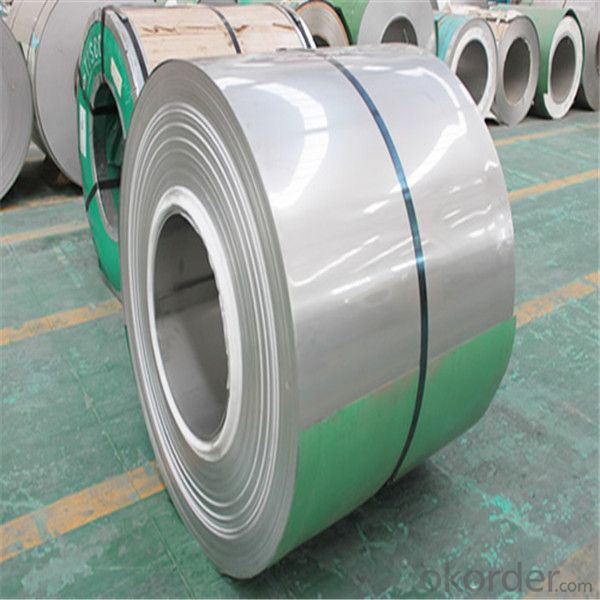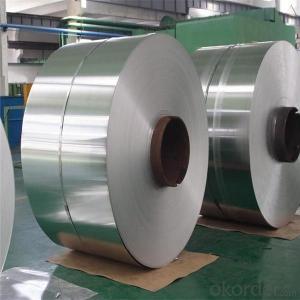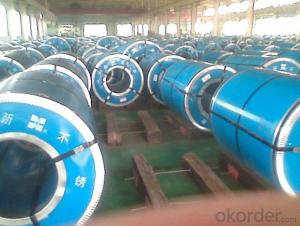Rich Stock 201 304 430 BA Stainless Steel Sheet/coil/sus
- Loading Port:
- Shanghai
- Payment Terms:
- TT OR LC
- Min Order Qty:
- 5 m.t.
- Supply Capability:
- 24000 m.t./month
OKorder Service Pledge
OKorder Financial Service
You Might Also Like
Item specifice
Quick information of 304 stainless steel coil
Model Name | 304 stainless steel coil |
Type | 201,202,304,304l,316,316l,321,410,430 |
Color | Silver white |
Standard | ASTM,AISI,DIN |
Surface | No.1,No.4,2B,BA,HL,8K, mirror |
Thickness | 0.3-6.0mm, or as your requirement |
Width | 100mm-2000mm, or as your requirement |
Length | 1000mm-6000mm, or as your requirement |
Feature | Corrosion and heat resistance, good toughness |
Application | 1: Chemical industry equipment, industrial tanks 2: Medical instruments, tableware, kitchen utensil and kitchen ware. 3: Architectural purpose, milk or food processing facilities. 4: Hospital equipment, interior exterior decoration for building 5: Architectural purposes, escalators, kitchen ware and vehicles. Or they can be made as your requirement. |
Chemical composition & physical properties
Chemical composition of Stainless Steel 304 | ||||||||
chemical element | C | Si | Mn | P | S | Cr | Ni | Others |
Ingredient | <=0.07 | <=1.0 | <=2.0 | <=0.035 | <=0.03 | 17.0-19.0 | 8.0-11.0 | |
Physical Properties of Stainless Steel 304 | |
Tensile Strength (MPa) | 520 |
Compression Strength (MPa) | 205-210 |
Proof Stress 0.2% (MPa) | 205-210 |
Elongation A5 (%) | Min40 |
Hardness Rockwell B | 92 |
Packaging & Shipping
Packaging Detail
Package | 1.Export sea worthy package + water proof paper + wooden pallet 2.Max Loading 26.5mt for each 20Gp container 3.Safe loading and fixing Professional teams 4.Professional shipping line |
Delivery Time | 7-15 days after deposite |
Our Services
Pre-sale Service
1.Sample can be offered with sample charge and courier fee by buyer's side.
2. We have full stock,and can deliver within short time.Many styles for your choices.
3.OEM and ODM order are accepted, Any kind of logo printing or design are available.
4.Good Quality + Factory Price + Quick Response + Reliable Service, is what we are trying best to offer you
5.All of our products are produce by our professional workman and we have our high-work-effect foreign
trade team, you can totally believe our service.
6.We have 8 year experience of design, manufacture and sell lingerie, we cherish every order from our honor.
After-sale choose
1. We are very glad that customer give us some suggestion for price and products.
2. If any question,please contact with us freely by E-mail or Telephone.


- Q:Can stainless steel strips be used for chemical reactors?
- Certainly! Chemical reactors can indeed utilize stainless steel strips. Stainless steel is widely preferred in the construction of chemical reactors owing to its exceptional resistance to corrosion, ability to withstand high temperatures, and overall durability. Its capacity to endure harsh chemical settings makes it an ideal choice for a diverse range of chemical reactions. When it comes to constructing reactors, stainless steel strips offer a flexible and economical solution as they can be effortlessly molded into desired configurations and dimensions. Additionally, stainless steel is simple to clean and maintain, guaranteeing the reactors' integrity while preventing any contamination during the chemical processes.
- Q:What are stainless steel strips used for?
- Due to their unique properties and versatility, stainless steel strips have a wide range of applications. Various industries, including automotive, construction, aerospace, and manufacturing, commonly utilize them. In the production of kitchen appliances and utensils, stainless steel strips are essential. Their corrosion-resistant nature prevents rust and staining, ensuring a longer lifespan for these products. Additionally, they are used to fabricate sinks, countertops, and backsplashes, which provide a durable and hygienic surface that is easy to clean. Within the automotive industry, stainless steel strips are employed in the manufacturing of exhaust systems, mufflers, and trim components. This is due to their high-temperature resistance and corrosion resistance, which guarantee longevity and performance even in harsh conditions. Construction and architecture also benefit from stainless steel strips. These strips can be found in structural components such as beams, columns, and reinforcement bars. In environments where corrosion or weathering is a concern, the durability and strength of stainless steel make it an ideal choice. The manufacturing industry relies on stainless steel strips for the fabrication of machinery and equipment. Conveyor belts, springs, and fasteners are all made using these strips. The strength, toughness, and resistance to wear and tear of stainless steel make it a reliable choice in these applications. In conclusion, stainless steel strips are essential materials in a wide range of applications. Their corrosion resistance, durability, strength, and aesthetic appeal make them versatile and indispensable in various industries.
- Q:How do stainless steel strips resist pitting?
- Stainless steel strips resist pitting due to the presence of chromium in the alloy, which forms a passive oxide layer on the surface. This oxide layer acts as a protective barrier, preventing the penetration of corrosive agents and thus reducing the risk of pitting corrosion.
- Q:What is the corrosion resistance of stainless steel strips in acidic environments?
- Stainless steel strips exhibit excellent corrosion resistance in acidic environments due to their high chromium content, which forms a protective oxide layer on the surface of the material. This oxide layer acts as a barrier, preventing the corrosive agents from reaching the underlying metal, thus ensuring longevity and durability in such conditions.
- Q:What are the common uses of stainless steel strips in the kitchen?
- Due to their unique properties and benefits, stainless steel strips find widespread use in the kitchen. An example of this is their common application for kitchen countertops and backsplashes. With their resistance to stains, heat, and corrosion, stainless steel strips are chosen as a durable and hygienic option for food preparation areas. Another way stainless steel strips are commonly employed in the kitchen is for the construction of kitchen appliances. Manufacturers often utilize stainless steel strips to craft the outer surfaces of refrigerators, dishwashers, ovens, and microwaves. This choice is driven by stainless steel's ease of cleaning, resistance to fingerprints, and ability to lend a sleek and modern appearance to the appliances. Stainless steel strips are also utilized for kitchen utensils and cutlery. The robustness and corrosion resistance of stainless steel make it an ideal material for crafting knives, forks, spoons, and other cooking tools. Stainless steel utensils not only endure for a long time but also resist rust and staining, ensuring their longevity and maintaining their visual appeal. Moreover, stainless steel strips are frequently employed for kitchen sinks. Stainless steel sinks are highly sought after due to their durability, low-maintenance nature, and resistance to staining, heat, and scratches. They offer an easy-to-clean and hygienic surface for washing dishes and engaging in food preparation. In addition to these conventional uses, stainless steel strips can be used for shelving, kitchen cabinets, range hoods, and other kitchen fixtures. Overall, stainless steel strips provide numerous advantages such as durability, resistance to corrosion and heat, ease of cleaning, and an elegant appearance, making them a preferred choice for various kitchen applications.
- Q:Are stainless steel strips resistant to pitting and crevice corrosion?
- Generally, stainless steel strips exhibit resistance to pitting and crevice corrosion. Stainless steel is renowned for its corrosion-resistant properties due to its high chromium content. When exposed to oxygen, chromium forms a protective layer called the passive film on the steel's surface. This film prevents the steel from interacting with its surroundings and shields it from corrosion, including pitting and crevice corrosion. However, the extent of corrosion resistance may differ depending on the specific grade and composition of the stainless steel, as well as the environmental conditions it encounters. Selecting the suitable grade of stainless steel for the particular application is crucial to ensure optimal protection against pitting and crevice corrosion.
- Q:How do stainless steel strips perform in high-pressure steam?
- Stainless steel strips perform exceptionally well in high-pressure steam environments due to their corrosion resistance and high temperature tolerance. They exhibit excellent strength and durability, ensuring minimal deformation or damage under extreme steam pressure conditions. Additionally, stainless steel's resistance to oxidation and scaling makes it an ideal choice for applications involving high-pressure steam, as it maintains its structural integrity and performance over extended periods.
- Q:Can stainless steel strips be used in the automotive parts industry?
- Yes, stainless steel strips can be used in the automotive parts industry. Stainless steel is highly durable, corrosion-resistant, and has excellent strength-to-weight ratio, making it suitable for various automotive applications such as exhaust systems, trim, brackets, and reinforcements. Moreover, stainless steel's aesthetic appeal and low maintenance requirements further contribute to its popularity in the automotive industry.
- Q:Can stainless steel strips be used in the food packaging industry?
- Yes, stainless steel strips can be used in the food packaging industry. Stainless steel is a highly durable and corrosion-resistant material that meets the hygiene standards required for food packaging. It provides a strong and reliable packaging solution, ensuring the safety and freshness of the food products.
- Q:What are the different thicknesses available for stainless steel strips?
- Stainless steel strips come in a variety of thicknesses to accommodate different applications and requirements. The thicknesses available for stainless steel strips typically range from 0.0015 inches (0.0381 mm) to 0.125 inches (3.175 mm) or even thicker, depending on the specific needs of the project. These thicknesses are often measured in gauge, with the most common being 22 gauge (0.030 inches) and 16 gauge (0.0625 inches). However, it is important to note that stainless steel strips can also be customized to meet specific thickness requirements if necessary. The choice of thickness will depend on factors such as the intended use of the strips, the level of durability and strength needed, and any specific industry standards or regulations that must be met.
1. Manufacturer Overview |
|
|---|---|
| Location | |
| Year Established | |
| Annual Output Value | |
| Main Markets | |
| Company Certifications | |
2. Manufacturer Certificates |
|
|---|---|
| a) Certification Name | |
| Range | |
| Reference | |
| Validity Period | |
3. Manufacturer Capability |
|
|---|---|
| a)Trade Capacity | |
| Nearest Port | |
| Export Percentage | |
| No.of Employees in Trade Department | |
| Language Spoken: | |
| b)Factory Information | |
| Factory Size: | |
| No. of Production Lines | |
| Contract Manufacturing | |
| Product Price Range | |
Send your message to us
Rich Stock 201 304 430 BA Stainless Steel Sheet/coil/sus
- Loading Port:
- Shanghai
- Payment Terms:
- TT OR LC
- Min Order Qty:
- 5 m.t.
- Supply Capability:
- 24000 m.t./month
OKorder Service Pledge
OKorder Financial Service
Similar products
New products
Hot products
Hot Searches
Related keywords




























